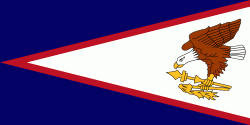Leone (Leone)
Leone is the second-largest city on Tutuila Island's west coast. The village is on the south-west coast of Tutuila Island, American Samoa. Leone was the ancient capital of Tutuila Island. Leone was also where the Samoan Islands’ first missionary, John Williams, visited on October 18, 1832. A monument in honor of Williams has been erected in front of Zion Church. Its large church was the first to be built in American Samoa. It has three towers, a carved ceiling and stained glass. Until steamships were invented, Leone was the preferred anchorage of sailing ships which did not risk entering Pago Pago Harbor. Much early contact between Samoans and Europeans took place in Leone.
The village is home to some of the oldest buildings on Tutuila Island. Besides the oldest church in American Samoa, Leone is home to a post office, high school, Pritchard's Bakery, and Kruse Supermarket. Buses from Fagatogo to Leone leave every few minutes throughout the year. An airstrip was built at Leone during World War II. The village is home to two historical sites listed on the U.S. National Register of Historic Places: Fagalele Boys School, which may be the oldest building on Tutuila Island, and Tataga-Matau Fortified Quarry Complex.
Until the invention of the motorboat, Pago Pago Harbor was of little value as the ships were unable to turn around in such a confined area. The most common anchorage was therefore in Leone, where the first missionaries also arrived. Its strategic location, directly over the southern horizon from Upolu Island, and the district Atua, has made Leone a major resting port for those traveling between Upolu, Tutuila, and the Manu'a Islands. Leone is now a lively municipal center. The origin of several of Leone's chiefly titles can be traced to Western Samoa.
The name originated from a famine that devastated Tutuila Island before modern history. Oral history shared through generations of ancestry recorded that Leone did not experience starvation nor the lack of food during this famine. Instead, the village had an abundance of food and other necessities, hence the name “Leone” which derives from “Le” (No) and “One” (Famine). During this famine, the villagers in Leone provided food and commodities for nearby villages and for families from a farther distance. This has earned the village the prestigious title “Leone o le Tinā o le Alofa”, which means “Leone is the Mother of Love.” The village's musical emblem is a living recording of this historical representation.
The village is home to some of the oldest buildings on Tutuila Island. Besides the oldest church in American Samoa, Leone is home to a post office, high school, Pritchard's Bakery, and Kruse Supermarket. Buses from Fagatogo to Leone leave every few minutes throughout the year. An airstrip was built at Leone during World War II. The village is home to two historical sites listed on the U.S. National Register of Historic Places: Fagalele Boys School, which may be the oldest building on Tutuila Island, and Tataga-Matau Fortified Quarry Complex.
Until the invention of the motorboat, Pago Pago Harbor was of little value as the ships were unable to turn around in such a confined area. The most common anchorage was therefore in Leone, where the first missionaries also arrived. Its strategic location, directly over the southern horizon from Upolu Island, and the district Atua, has made Leone a major resting port for those traveling between Upolu, Tutuila, and the Manu'a Islands. Leone is now a lively municipal center. The origin of several of Leone's chiefly titles can be traced to Western Samoa.
The name originated from a famine that devastated Tutuila Island before modern history. Oral history shared through generations of ancestry recorded that Leone did not experience starvation nor the lack of food during this famine. Instead, the village had an abundance of food and other necessities, hence the name “Leone” which derives from “Le” (No) and “One” (Famine). During this famine, the villagers in Leone provided food and commodities for nearby villages and for families from a farther distance. This has earned the village the prestigious title “Leone o le Tinā o le Alofa”, which means “Leone is the Mother of Love.” The village's musical emblem is a living recording of this historical representation.
Map - Leone (Leone)
Map
Country - American_Samoa
 |
 |
American Samoa consists of five main islands and two coral atolls; the largest and most populous island is Tutuila, with the Manuʻa Islands, Rose Atoll and Swains Island also included in the territory. All islands except for Swains Island are part of the Samoan Islands, The total land area is 199 sqkm, slightly more than Washington, D.C. As of 2022, the population of American Samoa is approximately 45,443 people, of whom the vast majority are indigenous ethnic Samoans. Most American Samoans are bilingual and can speak English and Samoan fluently.
Currency / Language
| ISO | Currency | Symbol | Significant figures |
|---|---|---|---|
| USD | United States dollar | $ | 2 |
| ISO | Language |
|---|---|
| EN | English language |
| SM | Samoan language |
| TO | Tongan language |















